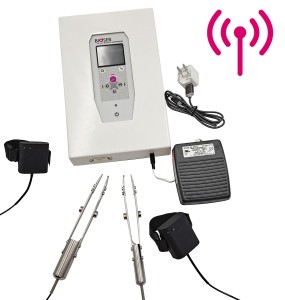Authors
O Sintsova, I Gladkikh, A Klimovich et al
Lab
Russian Academy of Sciences, Vladivostok, Russia
Journal
Biomedicines
Abstract
Currently the TRPV1 (transient receptor potential vanilloid type 1) channel is considered to be one of the main targets for pro-inflammatory mediators including TNF-alpha. Similarly, the inhibition of TRPV1 activity in the peripheral nervous system affects pro-inflammatory mediator production and enhances analgesia in total. In this study, the analgesic and anti-inflammatory effects of HCRG21, the first peptide blocker of TRPV1, were demonstrated in a mice model of carrageenan-induced paw edema. HCRG21 in doses of 0.1 and 1 mg/kg inhibited edema formation compared to the control, demonstrated complete edema disappearance in 24 h in a dose of 1 mg/kg, and effectively reduced the productionof TNF-alpha in both doses examined. ELISA analysis of blood taken 24 h after carrageenan administration showed a dramatic cytokine value decrease to 25 pg/mL by HCRG21 versus 100 pg/mL in the negative control group, which was less than the TNF-_ level in the intact group (40 pg/mL). The HCRG21 demonstrated potent analgesic effects on the models of mechanical and thermal hyperalgesia in carrageenan-induced paw edema. The HCRG21 relief effect was comparable to that of indomethacin taken orally in a dose of 5 mg/kg, but was superior to this nonsteroidal anti-inflammatory drug (NSAID) in duration (which lasted 24 h) in the mechanical sensitivity experiment. The results confirm the existence of a close relationship between TRPV1 activity and TNF-alpha production once again, and prove the superior pharmacological potential of TRPV1 blockers and the HCRG21 peptide in particular.
BIOSEB Instruments Used
Rodent pincher - analgesia meter (BIO-RP-M)
Source :

 Douleur - Allodynie/Hyperalgésie Thermique
Douleur - Allodynie/Hyperalgésie Thermique Douleur - Spontanée - Déficit de Posture
Douleur - Spontanée - Déficit de Posture Douleur - Allodynie/Hyperalgésie Mécanique
Douleur - Allodynie/Hyperalgésie Mécanique Apprentissage/Mémoire - Attention - Addiction
Apprentissage/Mémoire - Attention - Addiction Physiologie & Recherche Respiratoire
Physiologie & Recherche Respiratoire




































 Douleur
Douleur Système Nerveux Central (SNC)
Système Nerveux Central (SNC)  Neurodégénérescence
Neurodégénérescence Système sensoriel
Système sensoriel Système moteur
Système moteur Troubles de l'humeur
Troubles de l'humeur Autres pathologies
Autres pathologies Système musculaire
Système musculaire Articulations
Articulations Métabolisme
Métabolisme Thématiques transversales
Thématiques transversales Congrès & Meetings
Congrès & Meetings 